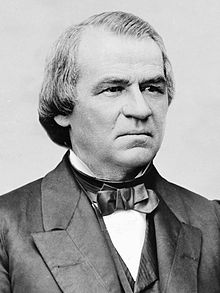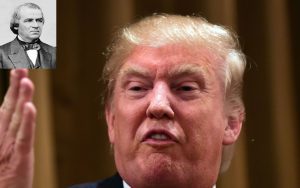Two Peas in a Pod: Trump and Andrew Johnson
Two Peas in a Pod: Trump and Andrew Johnson
With the announcement that he will not attend the inauguration of President Joseph Biden, outgoing President Donald Trump cemented the connection between himself and another one-term president who refused to attend the inauguration of his successor: Andrew Johnson.
For a century and a half, no president has cherished the goal of resembling Johnson, who succeeded the assassinated Abraham Lincoln after the Civil War. Johnson faced the first presidential impeachment after nearly four years of rubbing salt in the nation’s wounds from that bitter conflict.

From early days in the Trump term, the parallels between the two men were striking: both exhibited choleric dispositions, an inability to admit error, and a need for enemies to smite. Johnson’s bodyguard described him as the best hater he ever knew, while a fellow Tennessean, President James K. Polk, called him “vindictive and perverse.” Johnson accused his adversaries of aiming to behead him.
Trump has gloried in his rage, denouncing enemies in tumultuous rallies that feature insults and incitements to violence. He decries not only those who oppose him but also his own secretaries of state and defense (Rex Tillerson and James Mattis), attorney general (Jeff Sessions), and national security adviser (John Bolton). In an echo of totalitarian dictators of the twentieth century, Trump excoriates the media as “the true enemy of the people.”
Both Johnson and Trump aligned themselves with White Supremacists.

In 2017, Trump defended as “very fine people” the rioters in Nazi regalia in Charlottesville, Virginia. In recent months, he has embraced the violent White Supremacist group The Proud Boys. During a presidential debate, he urged them to “stand by.”
In expressing his commitment to white supremacy, Johnson did not need code phrases or dog whistles. He dismissed Blacks as incapable of participating in government without “relaps[ing] into barbarism,” and warned Americans that the greatest danger the United States had ever faced was that people of color would win political power and “Africanize” whole regions.
Trump and Johnson, of course, have parallel impeachment histories. Each man was impeached by the House of Representatives for “high crimes and misdemeanors,” then tried and acquitted by the Senate.
The unprecedented second Trump impeachment last week has moved Trump ahead of Johnson in the history of ignominy, yet Johnson does not fall far behind. He, too, was the target of two impeachment proceedings.
In December 1867, the Judiciary Committee of the House of Representatives reported impeachment articles against Johnson for his failure to enforce the post-Civil War Reconstructions statutes, though those articles failed in a vote before the full House. Two months later, a second impeachment resolution against Johnson sailed through the House by a 3-1 margin.
That second resolution, like the most recent impeachment resolution against Trump, involved occupation of a critical federal building
The invasion of the U.S. Capitol by Trump-incited rioters is too recent in memory to require further discussion. Johnson’s impeachment trial focused on his attempt to remove his Secretary of War, Edwin Stanton, who barricaded himself for nearly three months in the War Department building. Stanton refused to leave the building or relinquish his job to Johnson’s initial replacement, General Lorenzo Thomas, who attended Cabinet meetings but had no access to the inner workings of the national military.
When it comes to speed of impeachment, the two men again are neck-and-neck, though Johnson noses ahead. The House in 1868 approved its impeachment resolution against Johnson three days after the president’s attempt to fire Stanton. The second effort to impeach Trump was concluded after a comparatively leisurely seven days following the attack on the Capitol.
The two presidents will share one other characteristic. For as long as the United States is remembered, they will occupy the bottom rankings of the nation’s chief executives. It is impossible to project which will sink lowest. Every contest, after all, must have a loser.
Great piece, David. I especially like your last paragraph. “Swish” once again!